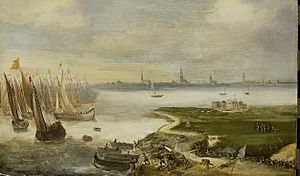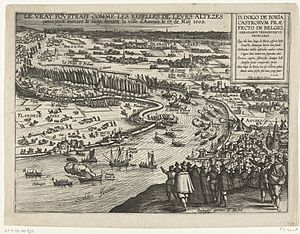Íñigo de Borja facts for kids
Don Íñigo de Borja y Velasco (1575–1622) was a Spanish nobleman and a skilled military leader. He is best known for serving as the governor of the Antwerp Citadel, a very important fortress in what is now Belgium.
Early Life and Family
Íñigo de Borja was born in 1575 in Gandía, Spain. He came from the famous Borja family, a very important noble house in Spain. His father was Francisco Tomás de Borja y Centelles, who was the sixth Duke of Gandia. His grandfather was also a duke, Íñigo Fernández de Velasco. Íñigo had a brother named Gaspar de Borja y Velasco, who became a very powerful and wealthy church leader in Spain.
Íñigo de Borja married a noblewoman from Flanders (a region in modern-day Belgium) named Hélène de Hénin-Liétard. She was the daughter of the Marquess of Veere. Together, they had five children:
- Don Gaspar de Borja y Hénin
- Don Francisco de Borja y Hénin
- Doña Juana de Borja y Hénin
- Doña María Teresa de Borja y Hénin
- Doña Ana Clara de Borja y Hénin
A Life in the Military
From a young age, Íñigo de Borja joined the military. He became a knight of the Order of Santiago, which was a special group of knights in Spain. In the 1590s, he fought for Philip II of Spain in France and Burgundy. After a peace treaty was signed in 1598, he served in northern Italy.
Defending Antwerp
In 1603, Íñigo de Borja moved to the Low Countries (which included modern-day Belgium and the Netherlands). He led a large group of 3,700 soldiers along the Spanish Road, a famous route used to move troops. In 1605, he became a hero when he defended Antwerp. A Dutch force, led by Ernest Casimir I, Count of Nassau-Dietz, tried to land at Blokkersdijk, a place across the river from Antwerp. Íñigo de Borja, leading the Antwerp soldiers, bravely stopped their attack. This important victory was celebrated in a special printed paper by Abraham Verhoeven, with a poem written by Cornelis Kiliaan.
Key Military Roles
Íñigo de Borja continued his military career. In 1606, he took part in the Siege of Grol, another important battle. He was then made the general of artillery for the Army of Flanders, meaning he was in charge of all the cannons and big guns. From 1606 until his death, he served as the governor of the Antwerp Citadel, a very important fortress that protected the city. In 1614, during a conflict called the War of the Jülich Succession, he helped capture the city of Wesel.
Don Íñigo de Borja died in Brussels on October 31, 1622.
See also
 In Spanish: Íñigo de Borja y Velasco para niños
In Spanish: Íñigo de Borja y Velasco para niños



